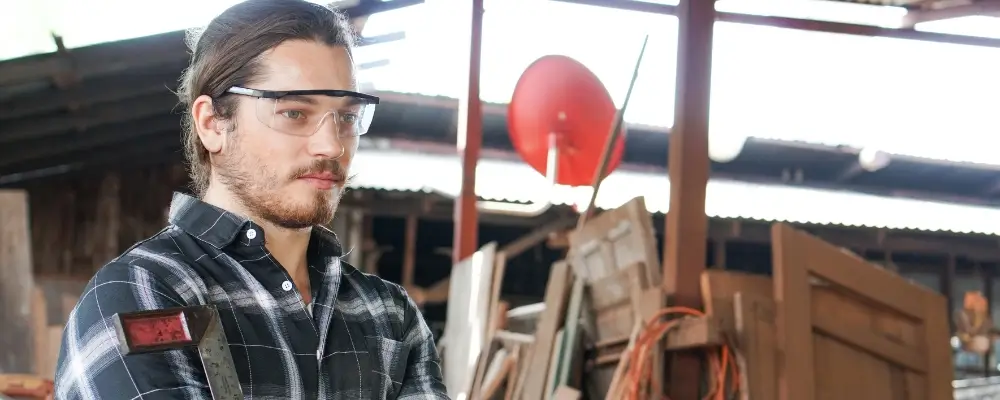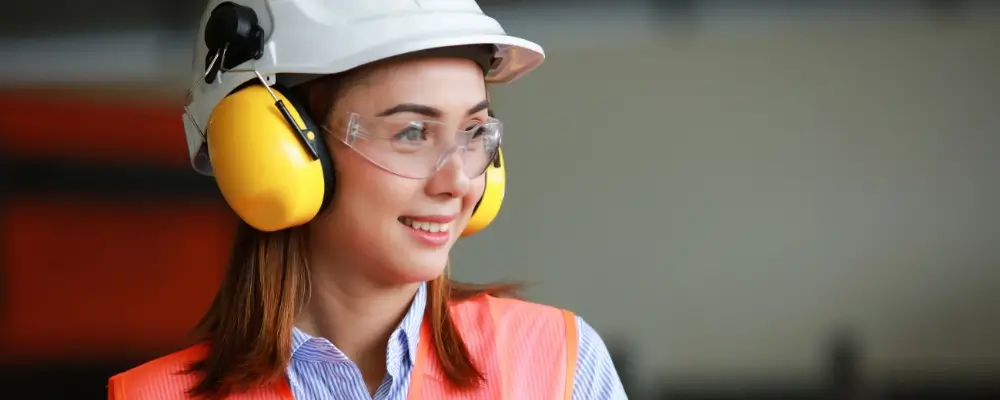Eye injuries can happen anywhere, from the bustling construction site to the quiet of your home workshop. Safety glasses are an indispensable tool that protects your precious eyesight from unexpected hazards.
This blog will uncover everything you need to know about safety glasses. We’ll explore their vital role in protecting your eyes, the diverse scenarios where they’re essential, and how to choose the right pair to keep you safe and seeing clearly. Whether you’re a professional tradesperson, a DIY enthusiast, or someone looking to protect their vision, this guide will arm you with the needed knowledge.

What Are Safety Glasses Used For?
Safety glasses protect the eyes from hazards and prevent injuries in various environments and activities. Here are some primary purposes for which safety glasses are used:
1. Protection from Flying Debris
- Wide range of hazards: Safety glasses create a physical barrier between your eyes and projectiles of all types, including wood splinters, metal shards, sparks, dust, concrete, and other debris.
- Common environments: Environments like construction sites, workshops, and manufacturing plants pose high risks from flying debris.
- Injury prevention: Without safety glasses, these particles can cause everything from minor irritation to severe eye damage, including cuts, puncture wounds, or even blindness.
2. Preventing Chemical Exposure
- Splashes and spills: Labs, factories, and even homes contain chemicals that can be highly dangerous upon contact with the eyes. Safety glasses prevent direct splashes from reaching your eyes.
- Fumes: Some chemicals release vapours that irritate, burn, or damage delicate eye tissue. Safety glasses (or, more often, goggles) form a shield to mitigate this risk.
- Types of damage: Chemical exposure can lead to burns, blindness, and long-term eye health problems.
3. Impact Resistance
- Forceful contact: Tools slipping, objects falling unexpectedly, or accidental collisions create impact hazards. Safety glasses are made of materials like polycarbonate, which are designed to resist shattering upon impact.
- Preventing blunt trauma: Even a “light” impact on the eye can have serious consequences. Safety glasses help protect against blunt force trauma that could cause internal damage to the eye.
4. UV Protection
- Invisible but harmful: Sunlight isn’t the only source of UV radiation; some workplace activities like welding also produce it. Safety glasses with UV protection block these rays.
- Short-term effects: UV exposure can cause a sunburn-like condition in the eye, which is very painful.
- Long-term damage: Prolonged UV exposure can increase the risk of cataracts, macular degeneration, and other eye diseases.
5. Preventing Eye Strain
- Glare reduction: Anti-glare coatings on safety glasses help reduce the distracting and uncomfortable effects of harsh light or glare, aiding focus and visual comfort.
- Screen fatigue: Tinted lenses on some safety glasses can ease strain if you regularly work with computers or other digital devices.
- Visual clarity: By reducing strain and improving light management, eye protective gear helps you work more efficiently and safely.

6. Sports and Recreational Safety
- Specific needs: Sports glasses are often tailored to individual activities, offering specialized impact protection and sometimes features for peripheral vision or light adjustment.
- Eye injuries: Sports can pose specific risks to your eyes, from fast-moving projectiles to unexpected collisions during play. Safety glasses minimize these.
- Prevention-focused: Sports-specific safety glasses help prevent serious injuries that could have lifelong effects on your vision.
7. Medical and Healthcare Use
- PPE: Splash-resistant safety glasses or goggles are a core part of the personal protective equipment (PPE) healthcare workers use to prevent contamination from bodily fluids or chemicals.
- Patient and worker safety: These glasses protect healthcare workers’ eyes and prevent cross-contamination between patients.
8. Preventing Workplace Injuries
- Employer responsibilities: Many workplaces require safety glasses, governed by standards like OSHA, to create a safe working environment.
- Reducing risk: Eye injuries are a significant source of lost work time and liability for employers. Safety glasses are essential preventative measures.
9. Enhancing Visual Clarity
- Prescription options: Many safety glasses are available with prescription lenses so you can maintain proper vision while staying protected.
- Specialized coatings: Anti-fog, anti-reflective, or other coatings on safety glasses can significantly improve visual clarity in specific environments.
10. Promoting Overall Eye Health
- Prevention is key: Safety glasses prevent a wide range of issues that could affect your eye health in the short and long term.
- Protection, not treatment: Injuries can be difficult or impossible to fully recover from. Proactive eye protection is the best way to maintain healthy eyesight for a lifetime.

When Should Safety Glasses Be Worn
Safety glasses should be worn when there is a risk of eye injury from flying particles, debris, chemicals, or other hazards. Here are some specific scenarios where safety glasses are typically required:
1. Industrial Settings
- Factories: Power tools, heavy machinery, and moving parts create potential hazards like flying metal fragments, wood splinters, and chemical splashes. Safety glasses shield your eyes from these dangers.
- Construction Sites: Construction involves working with debris, dust, nails, and power tools. Safety glasses protect your eyes from large and small particles that can be propelled with force.
- Workshops: Similar to the above, workshops frequently involve cutting, grinding, and handling potentially dangerous materials. Eye protection is a non-negotiable.
2. Laboratory Work
- Chemicals: Lab work often involves handling corrosive, toxic, or reactive chemicals. Even minute chemical splashes can cause severe eye damage, and many chemicals can emit harmful vapours. Safety glasses or goggles provide splash protection and sometimes fume protection.
- Glassware: Glass beakers, tubes, and other laboratory equipment can shatter unexpectedly. Safety glasses act like a shield, protecting your eyes from fragments.
3. Woodworking
- Sawdust and Wood Chips: Power saws, sanders, and woodworking tools produce high-speed wood particles and debris. These can cause eye irritation, lacerations, or even more serious damage if they penetrate the eye.
4. Metalworking
- Sparks and Shards: Welding, grinding and metal fabrication create intense sparks and often propel small metal fragments with force. Safety glasses are designed to withstand this impact, preventing potentially severe eye injuries.
5. Landscaping and Gardening
- Power Tools: Mowing, trimming, or using a chainsaw can propel rocks, woodchips, or debris at high speeds that could lead to eye injuries.
- Chemicals: Fertilizers and pesticides contain chemicals that can irritate or harm your eyes. Safety glasses offer a vital layer of protection during application.
6. Sports and Recreational Activities
- Impact Protection: High-velocity sports like shooting, cycling, skiing, and confident ball sports carry the risk of projectiles or equipment striking the eyes.
- Collisions: Accidental collisions with other players or equipment can cause unpredictable eye injuries in some sports. Safety glasses designed for sports can mitigate these risks.
7. DIY Home Improvement Projects
- Mechanical Hazards: Drilling, hammering, sawing, and using power tools to throw particles of wood, metal, drywall, and other materials. Safety glasses safeguard your vision from unexpected projectiles.
8. Medical and Healthcare Settings
- Exposure Risks: Healthcare professionals handle bodily fluids and potentially infectious materials. Splashproof safety glasses or goggles are essential to prevent eye contamination.
9. Chemical Handling
- Splash Hazards: Many industrial and household chemicals are corrosive or toxic to the eyes. Safety glasses act as a protective barrier to avoid harm from accidental splashes.
- Fumes: Certain chemicals can release vapours or fumes that irritate or damage the eyes. Depending on the chemical, safety glasses or goggles designed for fume protection may be necessary.
10. Any Situation with Potential Eye Hazards
- Risk Assessment: Always take a moment to evaluate any task and identify potential risks to your vision. If there is a chance of projectile, splash, or other hazards, wear safety glasses before starting work.
Remember: Your eyesight is precious. Prevention is always better than dealing with the consequences of an eye injury. Make safety glasses your instinctive choice wherever eye protection is needed.
Conclusion
Safety glasses may seem like small equipment, but they are important in safeguarding your vision. Whether tackling a major project or a simple household task, prioritize eye protection. By understanding the risks, choosing the right safety glasses, and making them a habit, you’ll take a proactive step towards preserving your eyesight for years. Remember, prevention is always better than cure when protecting your precious eyes.

